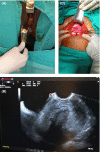Chronic uterine inversion: Mimicking uterine cervical polyp or leiomyoma
- PMID: 39114841
- PMCID: PMC11305835
- DOI: 10.1002/ccr3.9288
Chronic uterine inversion: Mimicking uterine cervical polyp or leiomyoma
Abstract
Key clinical message: The diagnosis of chronic uterine inversion occurs after birth or secondary to pathologies of the pelvic region organs. Especially, the diagnosis and treatment of isolated chronic inversion rapidly under appropriate conditions seem to reduce maternal morbidity and mortality.
Abstract: Chronic uterine inversion is a rare clinical diagnosis and difficult to diagnose and treat. This is a 22-year-old patient with no particular history known for a month for uterine fibroid with a polyp, who gave birth through the cervix in the context of subfertility for a year. Non puerperal uterine inversion is a rare clinical condition, and it should be kept in mind that this may be uterine inversion when mass lesions causing clinical complaints are detected, especially in the vulva, vagina, and cervix uteri region. The quality of life of the patients is increased by reducing the morbidity and mortality rates by making a diagnosis with a good clinical and ultrasonographic evaluation.
Keywords: chronic uterine inversion; leiomyoma; nonpuerperal; uterine cervical polyp; uterine fibroid.
© 2024 The Author(s). Clinical Case Reports published by John Wiley & Sons Ltd.
Conflict of interest statement
All authors have no conflicts of interests to declare.
Figures
Similar articles
-
Nonpuerperal vaginal hemorrhage secondary to complete uterine inversion: A case report.Radiol Case Rep. 2020 Dec 22;16(3):543-546. doi: 10.1016/j.radcr.2020.12.045. eCollection 2021 Mar. Radiol Case Rep. 2020. PMID: 33384753 Free PMC article.
-
Totally inverted cervix due to a huge prolapsed cervical myoma simulating chronic non-puerperal uterine inversion.Int J Surg Case Rep. 2014;5(8):513-5. doi: 10.1016/j.ijscr.2013.12.014. Epub 2014 May 21. Int J Surg Case Rep. 2014. PMID: 24997386 Free PMC article.
-
Uterine Inversion Secondary to Endometrial Carcinoma.J Med Cases. 2023 Jan;14(1):7-12. doi: 10.14740/jmc4023. Epub 2022 Dec 30. J Med Cases. 2023. PMID: 36755999 Free PMC article.
-
An exceptional uterine inversion in a virgo patient affected by submucosal leiomyoma: Case report and review of the literature.J Obstet Gynaecol Res. 2019 Feb;45(2):466-472. doi: 10.1111/jog.13806. Epub 2018 Sep 5. J Obstet Gynaecol Res. 2019. PMID: 30187623 Review.
-
Non-puerperal inversion of the uterus caused by leiomyosarcoma: a case report and clinical management.J Obstet Gynaecol Res. 2007 Jun;33(3):402-6. doi: 10.1111/j.1447-0756.2007.00546.x. J Obstet Gynaecol Res. 2007. PMID: 17578377 Review.
Cited by
-
Postpartum acute intrauterine inversion: A case report.Medicine (Baltimore). 2025 Jul 25;104(30):e43013. doi: 10.1097/MD.0000000000043013. Medicine (Baltimore). 2025. PMID: 40725912 Free PMC article.
References
Publication types
LinkOut - more resources
Full Text Sources


